Structure of The Heart (A-level Biology)
Structure of The Heart
Human Heart
The Structure of Human Heart
- The heart is the control for the circulatory system. It is a muscle that pumps blood around the body.
- The heart consists of two muscular pumps that lay next to each other. The right side pumps deoxygenated blood to the lungs, whereas the left side pumps oxygenated blood to the whole body.
- There are four chambers in total. The right and left atria lie above the right and left ventricles, all separated by valves.
- The atria have thin walls. They receive blood that is returning to the heart and force blood into the ventricles.
- The ventricles have thicker walls than the atria. This is because they have to pump blood a further distance than the atria (out of the heart and to the rest of the body) and withstand higher pressures.
- 4 main blood vessels are located in the heart:
- Pulmonary vein, where blood flows from lungs to left atrium
- Aorta, where blood flows from left atrium to body
- Vena cava, which allowed deoxygenated blood from the body to enter the heart at the right atrium
- Pulmonary artery, which allows the blood to travel from the right ventricle to the lungs.
- The valves of the heart only open one way. They only open when there is higher pressure behind the valve, and this ensures that blood only flows in one direction (is unidirectional), preventing back flow.
- The atrioventricular (AV) valves connect the atria to the ventricles. They stop blood flowing back into the atria when the ventricles contract and are also known as the tricuspid and bicuspid valves.
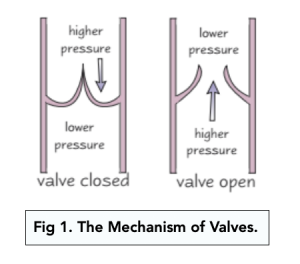
- Tendinous chords, also known as valve tendons, prevent atrioventricular valves turning inside out. This can happen due to the pressure inside.
- Tricuspid valve separates the right atria from the right ventricle; the bicuspid/mitral valve separates the left atria from the left ventricle.
- The semilunar (SL) valves connect the ventricles to the arteries (pulmonary artery and aorta). They prevent the flow of blood back into the heart.
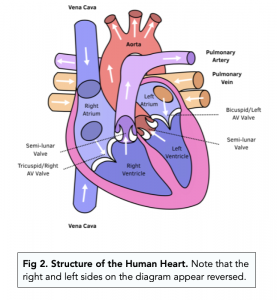
- The septum consists of muscle and connective tissue. It prevents oxygenated and deoxygenated blood from mixing.
- The coronary artery wraps around the heart. This supplies blood to the cardiac muscle, the heart.
Pattern of Blood Circulation in a Mammal
- Circulatory systems can be opened or closed and single or double. In the case of humans (mammals), it is closed, where blood is confined to blood vessels only, and double.
- The circulatory system is responsible for transporting blood around the body. It is made up of the heart and various blood vessels.
- Mammals have a double circulatory system. This means that blood is pumped through the heart twice when it makes a full circuit of the body, which ensures that blood circulation isn’t too slow.
Advantages of a double circulatory system:
- Maintained concentration gradient – this is due to oxygenated and deoxygenated blood not mixing.
- Blood pressure to lungs is slower – to avoid damaging delicate tissues and increase time for gas exchange.
- Blood pressure to body tissues is higher.
You need to know the names of the coronary arteries and of the blood vessels entering and leaving the heart, lungs and kidneys:
-
- The left and right coronary arteries – supply the heart with blood.
-
- The vena cava – carries deoxygenated blood from the body to the heart.
-
- The pulmonary vein – carries oxygenated blood from the lungs to the heart.
-
- The aorta – carries oxygenated blood from the heart to the rest of the body.
-
- The pulmonary artery – carries deoxygenated blood from the heart to the lungs.
-
- The renal vein – carries deoxygenated blood from the kidneys to the vena cava.
-
- The renal artery – carries oxygenated blood from the aorta to the kidneys.
- The renal artery – carries oxygenated blood from the aorta to the kidneys.
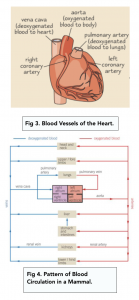
Heart Function
The hearts function is to provide oxygenated blood to the body.
The left side of the heart is responsible for oxygenated pumping blood out to the body, known as systemic circulation, whilst the right side of the heart’s job is to pump deoxygenated blood to the lungs to become oxygenated again, known as pulmonary circulation.
Blood Route Taken
- Blood enters the heart. Deoxygenated blood flows into the right atrium from the body via the vena cava.
- The superior vena cava drains blood from the upper portion of the body.
- The inferior vena cava drains blood from the lower portion of the body.
- Moves to the right ventricle. This blood travels from the right atrium to the right ventricle, passing through the tricuspid valve.
- Enters the heart. This exits the heart via the pulmonary artery, becoming oxygenated in the lungs.
- Leaves the lungs. The fresh blood leaves via the pulmonary vein to the left atrium.
- Enters the left ventricle. It passes through the mitral valve to reach the left ventricle.
- Leaves the heart. It then leaves the heart via the aorta to reach the rest of the body.
- Repeat. It returns to the vena cava and the process begins again.
The Cardiac Cycle
The cardiac cycle is a sequence contraction (systole) and relaxation (diastole) of the atria and ventricles. This cycle ensures that blood is continuously circulated around the body.
The pressure changes created by contraction and relaxation of the atria and ventricles open and close the hearts valves, ensuring that blood only moves in one direction.
- Cardiac diastole – both the atria and ventricles are relaxed (0.4 seconds). Whilst the heart is in the relaxation phase, blood enters the atria. As this happens, the pressure behind the AV valves increases, pushing them open. Blood then enters the ventricles from the atria and the SL valves remain closed.
- Atrial systole – atria contract and ventricles remain relaxed (0.1 second). The atria contract to push any remaining blood into the ventricles. The SL valves remain closed.
- Ventricular systole – the atria relax and the ventricles contract (0.3 seconds). The ventricles contract after a certain amount of blood is filled, increasing the pressure, closing the atrioventricular valves. In response to the pressure, the semilunar valves open where blood flows out of the heart. As the pressure decreases, the semilunar valves then close.
Heart sounds help to identify what is happening within the heart during the cardiac cycle.
As the ventricular valves close, the ‘Lub’ sound is created, commonly referred to as S1; as the semilunar valves close, the ‘Dub’ sound is created, known as S2.
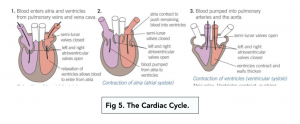
Coordination of the Heart
The heart has the ability to generate its own contraction, so it is common referred to as myogenic. The process of how this occurs is outlined below:
- Heartbeat begins at sinoatrial node (SAN). These are specialised fibres in the wall of the right atrium. They are collectively known as the ‘pacemaker of the heart’ due to generating a wave of electrical stimulation (depolarisation).
- Depolarisation spreads through the atria, where they contract. The electrical wave cannot speed directly to the ventricles due to region of nonconductive tissue, known as annulus fibrosis, at the base of the atria.
- Atrioventricular nodes (AVN) stimulated by electrical wave. Depolarisation passed into conducting fibres, known as Bundle of His.
- Ventricles contract. Bundle of His splits into two branches, known as Purkinje fibres, based in the apex, which carry the wave upwards to the ventricles. This delay enable the ventricles to fill with a sufficient amount of blood before contracting.
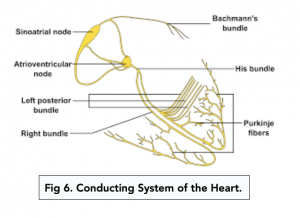
Calculating Cardiac Output
Cardiac output (CO) is the amount of blood ejected from the heart in one minute.
The heart rate (HR )is the number or contractions (heartbeats) per minute.
Stroke volume (SV) is the amount of blood ejected from the heart with each contractions.
To calculate the cardiac output, you multiple the heart rate by the stroke volume.

Electrocardiogram (ECG)
An electrocardiogram is a device used to visualise what the electrical activity in the heart is doing.
Electrodes are attached to sticky labels placed on the skins surface, which are placed in various locations around the heart area. These electrodes sense and record electrical signals that are spread through the heart.
The final recording is a series of waveforms which can be interpreted to look for signs of:
- Changes in heart rate. Brachycardia is a slow heart rate, beating below 60 beats per minute. Tachycardia, a fast heart rate, is defined as more than 100 beats per minute.
- Rhythm. Whether it is regular or irregular
- Length of cardiac cycle phases.
- Onset of a heart attack.
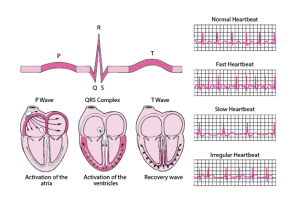
Blood
Functions of Blood
Blood serves to function as a means of transport, defence and formation of lymph and tissue fluid.
It is made up of plasma and blood cells (erythrocytes, leucocytes and platelets).
Plasma
Plasma is used to transfer heat around the body and transport:
- Digested food products, such as glucose and amino acids
- Nutrient molecules
- Hormones
- Excretory products, like carbon dioxide and urea
Erythrocytes
Erythrocytes are red blood cells which are able to transport oxygen via haemoglobin and some carbon dioxide. Their biconcave shape and lack of nucleus are adaptations in order to fit through capillaries.
Leucocytes
There are two groups of leucocytes (white blood cells) present in blood are granulocytes and agranulocytes.
Some examples of granulocytes are:
- Neutrophils, used in the process of phagocytosis
- Basophils, these contain histamine, which is used in an inflammation/allergic response
- Eosinophils, which react in response to parasites, allergic reactions and inflammation as well as immunity.
Examples of agranulocytes are:
- Monocytes
- Lymphocytes
Platelets
Platelets include fragments of megakaryocytes, which are used in the process of blood clotting.
Blood Clotting
Thrombosis is the process of forming a blood clot, known as a thrombus, within a blood vessel. It acts to prevent blood loss when a blood vessel is damaged, as well as preventing the entry of disease from microorganisms. It also works to provide a framework to begin repairing.
A cascade of reactions lead to a clot formation:
- Platelets attach. When a blood vessel is damaged, platelets attach to the exposed collagen fibres.
- Thromboplastin is released from platelets. This protein triggers a conversion of inactive prothrombin (a protein), into the active thrombin (an enzyme). For this to happen, calcium ions and vitamin K must be present.
- Network formed. Thrombin catalyses the conversion of soluble fibrinogen into insoluble fibrin. This forms a network of fibres where platelets, erythrocytes and debris are trapped to form the blood clot.
Atherosclerosis
Atherosclerosis is the hardening of arteries caused by the build-up of fibrous plaque, known as atheroma.
Atheroma formation is the cause of many cardiovascular diseases.
The process of formation occurs as following:
- Endothelium damaged. The endothelium, which lines the arteries, gets damaged by factors such as high cholesterol, smoking or high blood pressure.
- Inflammatory response. This increases the risk of blood clotting in the artery, which leads to an inflammatory response. This causes white blood cells to move to this site.
- Plaque (atheroma) forms. Over time, white blood cells, cholesterol, calcium salts and fibres build-up, leading to the formation of plaque.
A build-up of fibrous plaque leads to the narrowing of that artery, in turn restricting blood flow. This increases the blood pressure, damaging the endothelial lining elsewhere in the artery, where the whole process repeats.
Atherosclerosis is a multi-factorial disease which has modifiable and non-modifiable risk factors. Some of these factors increasing the risk include:
- Genetics
- Age
- Diet
- Gender
- High blood pressure
- High cholesterol levels
- Smoking
- Physical inactivity
- Obesity
We can, in turn, reduce the risk of cardiovascular disease by implementing activities to combat these factors, such as:
- Stopping smoking
- Regular exercise
- Reducing alcohol consumption
- Dietary changes
- Maintaining healthy bodyweight
As a result of cardiovascular disease, atherosclerosis can cause:
- Angina
- Stroke
- Myocardial infarction
- Aneurism
Blood Pressure (BP)
Having sufficient blood pressure enables blood to travel around all parts of our body, supplying oxygen and nutrients along the way.
Factors that can affect blood pressure include:
- Age
- Diet
- Smoking
- Dehydration
- Exercise
- Stress
- Medication
- Disease (of the heart and/or kidneys)
Measuring Blood Pressure
Blood pressure can be measured both manually and automatically.
If you were to automatically measure blood pressure, you would only need to press the on button before the machine calculated everything for you.
If you were to manually measure blood pressure, you would need a stethoscope and a sphygmomanometer (BP cuff machine).
How to measure blood pressure:
- Tie blood pressure cuff around upper arm (making sure its not too tight or loose)
- Listen over the brachial artery with a stethoscope
- Inflate the cuff to around 160-200mmHg
- Slowly begin to deflate the cuff, listening out for:
- The first occurrence of rhymes sounds, where blood flows through the artery. This is the systolic reading.
- The pressure when the sounds stop. This is the diastolic reading.
Repeat this 3 times and take the average.
The systolic pressure is the higher measurement which is calculated when the heart beats. The diastolic pressure us the lower measurement when the heart rests between beats.
The diagram below shows a guide to a normal blood pressure reading, as well as it being too low and in hypertension stages:
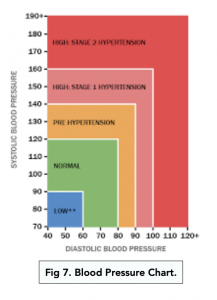
In conclusion, we have covered here the structure of the heart, the function of the heart, coordination of the heart, and the main blood vessels of the heart. The heart is one of the most vital organs in the body, and its function is essential for maintaining life. Any disruption to the heart function, whether due to disease, injury, or other factors, can have serious consequences for health and well-being.
FAQs
The heart is a complex organ composed of muscle tissue, blood vessels, and connective tissue. It is divided into four chambers: the right and left atria, and the right and left ventricles.
The heart function is responsible for pumping blood throughout the body. The right atrium and ventricle work together to pump deoxygenated blood to the lungs, while the left atrium and ventricle work together to pump oxygenated blood to the rest of the body.
The major blood vessels of the heart include the aorta, vena cava, pulmonary artery, and pulmonary vein. These vessels transport blood to and from the heart.
Blood flows through the heart in a specific sequence. Deoxygenated blood enters the right atrium, where it is then pumped into the right ventricle. From the right ventricle, it is pumped into the lungs, where it is oxygenated. Oxygenated blood then returns to the heart and enters the left atrium, where it is pumped into the left ventricle. The left ventricle then pumps oxygenated blood to the rest of the body through the aorta.
Heart valves play a critical role in regulating the flow of blood through the heart. They prevent blood from flowing backward and ensure that blood flows in the correct direction through the heart.
The heart beats as a result of the coordinated contraction and relaxation of the muscle fibers in the heart. This is controlled by the electrical signals generated by the sinoatrial (SA) node and the atrioventricular (AV) node.
The electrical conduction system of the heart is responsible for generating the electrical signals that control the contraction and relaxation of the heart muscle fibers. This system ensures that the heart beats in a coordinated and efficient manner.
The structure of the heart is a fundamental aspect of human physiology and is studied in A-level Biology as part of the circulatory system. Understanding the structure and function of the heart is essential for understanding how the body transports oxygen, nutrients, and waste products. It is also important for understanding heart disease and other cardiovascular conditions.
The heart is coordinated by a specialized group of cells called the cardiac conduction system. This system consists of several structures that work together to generate and conduct electrical impulses throughout the heart, which coordinate the contraction of its muscle cells.
The cardiac conduction system includes the following structures:
Sinoatrial (SA) node: Located in the upper wall of the right atrium, this node is known as the pacemaker of the heart. It generates an electrical impulse that spreads throughout the atria, causing them to contract.
Atrioventricular (AV) node: Located between the atria and ventricles, this node receives the electrical impulse from the SA node and delays it slightly before transmitting it to the ventricles.
Bundle of His: A bundle of specialized fibers that transmit the electrical impulse from the AV node to the ventricles.
Purkinje fibers: Located in the walls of the ventricles, these fibers conduct the electrical impulse to the individual muscle cells of the ventricles, causing them to contract in a coordinated manner.
The coordination of the cardiac conduction system ensures that the heart contracts in a coordinated manner, pumping blood efficiently throughout the body. Any disruption in this system can lead to irregular heartbeats, or arrhythmias, which can have serious consequences for health.





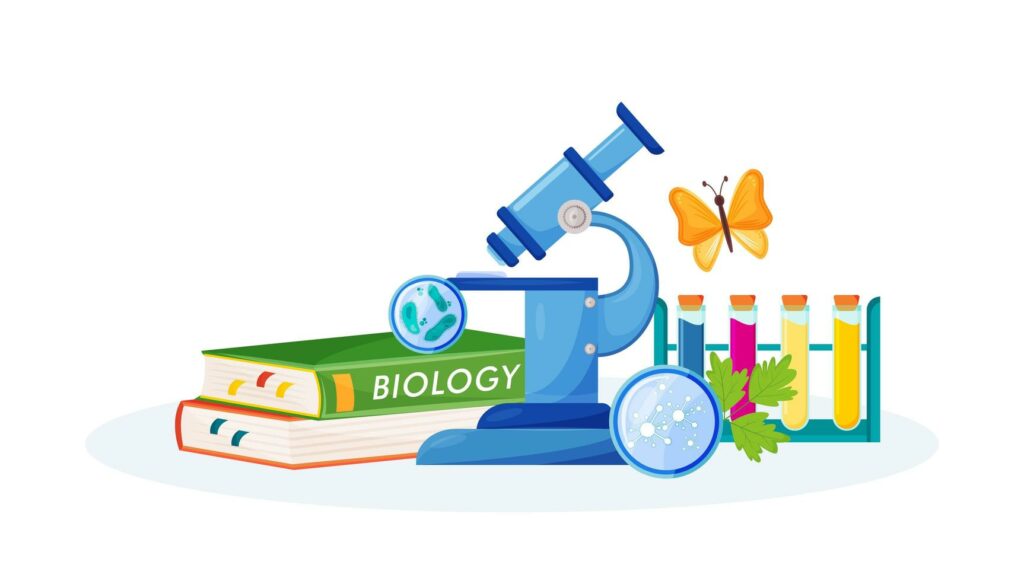
Still got a question? Leave a comment
Leave a comment